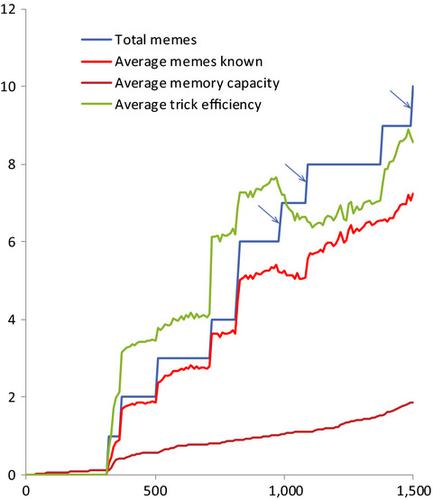当前位置:
X-MOL 学术
›
Ecol. Evol.
›
论文详情
Our official English website, www.x-mol.net, welcomes your
feedback! (Note: you will need to create a separate account there.)
Runaway brain-culture coevolution as a reason for larger brains: Exploring the "cultural drive" hypothesis by computer modeling.
Ecology and Evolution ( IF 2.3 ) Pub Date : 2020-05-20 , DOI: 10.1002/ece3.6350 Alexander V Markov 1, 2 , Mikhail A Markov 1, 2
Ecology and Evolution ( IF 2.3 ) Pub Date : 2020-05-20 , DOI: 10.1002/ece3.6350 Alexander V Markov 1, 2 , Mikhail A Markov 1, 2
Affiliation

|
Scale and tempo of brain expansion in the course of human evolution implies that this process was driven by a positive feedback. The “cultural drive” hypothesis suggests a possible mechanism for the runaway brain‐culture coevolution wherein high‐fidelity social learning results in accumulation of cultural traditions which, in turn, promote selection for still more efficient social learning. Here we explore this evolutionary mechanism by means of computer modeling. Simulations confirm its plausibility in a social species in a socio‐ecological situation that makes the sporadic invention of new beneficial and cognitively demanding behaviors possible. The chances for the runaway brain‐culture coevolution increase when some of the culturally transmitted behaviors are individually beneficial while the others are group‐beneficial. In this case, “cultural drive” is possible under varying levels of between‐group competition and migration. Modeling implies that brain expansion can receive additional boost if the evolving mechanisms of social learning are costly in terms of brain expansion (e.g., rely on complex neuronal circuits) and tolerant to the complexity of information transferred, that is, make it possible to transfer complex skills and concepts easily. Human language presumably fits this description. Modeling also confirms that the runaway brain‐culture coevolution can be accelerated by additional positive feedback loops via population growth and life span extension, and that between‐group competition and cultural group selection can facilitate the propagation of group‐beneficial behaviors and remove maladaptive cultural traditions from the population's culture, which individual selection is unable to do.
中文翻译:

失控的大脑文化共同进化是大脑更大的原因:通过计算机建模探索“文化驱动”假设。
人类进化过程中大脑扩张的规模和节奏意味着这一过程是由正反馈驱动的。 “文化驱动”假说提出了一种失控的大脑文化协同进化的可能机制,其中高保真的社会学习导致文化传统的积累,反过来又促进了更有效的社会学习的选择。在这里,我们通过计算机建模来探索这种进化机制。模拟证实了它在社会生态环境中的社会物种中的合理性,这使得新的有益和认知要求行为的零星发明成为可能。当一些文化传播的行为对个人有利而另一些则对群体有利时,失控的大脑文化共同进化的机会就会增加。在这种情况下,“文化驱动”在不同程度的群体间竞争和迁移下是可能的。建模表明,如果社会学习的进化机制在大脑扩展方面代价高昂(例如,依赖于复杂的神经元回路)并且能够容忍所传递信息的复杂性,也就是说,使得传递复杂的信息成为可能,那么大脑扩展可以得到额外的推动。轻松掌握技能和概念。人类语言大概符合这种描述。建模还证实,失控的大脑文化共同进化可以通过人口增长和寿命延长等额外的正反馈循环来加速,并且群体间竞争和文化群体选择可以促进群体有益行为的传播并消除适应不良的文化传统个体选择无法做到这一点。
更新日期:2020-06-26
中文翻译:

失控的大脑文化共同进化是大脑更大的原因:通过计算机建模探索“文化驱动”假设。
人类进化过程中大脑扩张的规模和节奏意味着这一过程是由正反馈驱动的。 “文化驱动”假说提出了一种失控的大脑文化协同进化的可能机制,其中高保真的社会学习导致文化传统的积累,反过来又促进了更有效的社会学习的选择。在这里,我们通过计算机建模来探索这种进化机制。模拟证实了它在社会生态环境中的社会物种中的合理性,这使得新的有益和认知要求行为的零星发明成为可能。当一些文化传播的行为对个人有利而另一些则对群体有利时,失控的大脑文化共同进化的机会就会增加。在这种情况下,“文化驱动”在不同程度的群体间竞争和迁移下是可能的。建模表明,如果社会学习的进化机制在大脑扩展方面代价高昂(例如,依赖于复杂的神经元回路)并且能够容忍所传递信息的复杂性,也就是说,使得传递复杂的信息成为可能,那么大脑扩展可以得到额外的推动。轻松掌握技能和概念。人类语言大概符合这种描述。建模还证实,失控的大脑文化共同进化可以通过人口增长和寿命延长等额外的正反馈循环来加速,并且群体间竞争和文化群体选择可以促进群体有益行为的传播并消除适应不良的文化传统个体选择无法做到这一点。











































 京公网安备 11010802027423号
京公网安备 11010802027423号